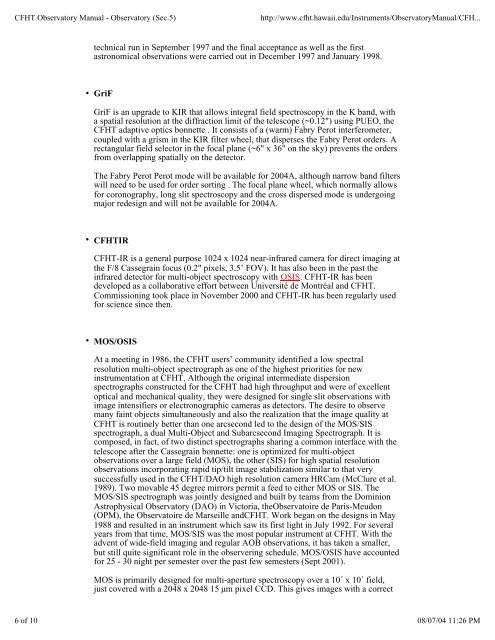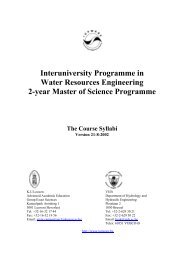CFHT operating manual - Homepage Usask
CFHT operating manual - Homepage Usask
CFHT operating manual - Homepage Usask
Create successful ePaper yourself
Turn your PDF publications into a flip-book with our unique Google optimized e-Paper software.
<strong>CFHT</strong> Observatory Manual - Observatory (Sec.5) http://www.cfht.hawaii.edu/Instruments/ObservatoryManual/CFH...<br />
technical run in September 1997 and the final acceptance as well as the first<br />
astronomical observations were carried out in December 1997 and January 1998.<br />
GriF<br />
GriF is an upgrade to KIR that allows integral field spectroscopy in the K band, with<br />
a spatial resolution at the diffraction limit of the telescope (~0.12") using PUEO, the<br />
<strong>CFHT</strong> adaptive optics bonnette . It consists of a (warm) Fabry Perot interferometer,<br />
coupled with a grism in the KIR filter wheel, that disperses the Fabry Perot orders. A<br />
rectangular field selector in the focal plane (~6" x 36" on the sky) prevents the orders<br />
from overlapping spatially on the detector.<br />
The Fabry Perot Perot mode will be available for 2004A, although narrow band filters<br />
will need to be used for order sorting . The focal plane wheel, which normally allows<br />
for coronography, long slit spectroscopy and the cross dispersed mode is undergoing<br />
major redesign and will not be available for 2004A.<br />
<strong>CFHT</strong>IR<br />
<strong>CFHT</strong>-IR is a general purpose 1024 x 1024 near-infrared camera for direct imaging at<br />
the F/8 Cassegrain focus (0.2" pixels, 3.5’ FOV). It has also been in the past the<br />
infrared detector for multi-object spectroscopy with OSIS. <strong>CFHT</strong>-IR has been<br />
developed as a collaborative effort between Université de Montréal and <strong>CFHT</strong>.<br />
Commissioning took place in November 2000 and <strong>CFHT</strong>-IR has been regularly used<br />
for science since then.<br />
MOS/OSIS<br />
At a meeting in 1986, the <strong>CFHT</strong> users’ community identified a low spectral<br />
resolution multi-object spectrograph as one of the highest priorities for new<br />
instrumentation at <strong>CFHT</strong>. Although the original intermediate dispersion<br />
spectrographs constructed for the <strong>CFHT</strong> had high throughput and were of excellent<br />
optical and mechanical quality, they were designed for single slit observations with<br />
image intensifiers or electronographic cameras as detectors. The desire to observe<br />
many faint objects simultaneously and also the realization that the image quality at<br />
<strong>CFHT</strong> is routinely better than one arcsecond led to the design of the MOS/SIS<br />
spectrograph, a dual Multi-Object and Subarcsecond Imaging Spectrograph. It is<br />
composed, in fact, of two distinct spectrographs sharing a common interface with the<br />
telescope after the Cassegrain bonnette: one is optimized for multi-object<br />
observations over a large field (MOS), the other (SIS) for high spatial resolution<br />
observations incorporating rapid tip/tilt image stabilization similar to that very<br />
successfully used in the <strong>CFHT</strong>/DAO high resolution camera HRCam (McClure et al.<br />
1989). Two movable 45 degree mirrors permit a feed to either MOS or SIS. The<br />
MOS/SIS spectrograph was jointly designed and built by teams from the Dominion<br />
Astrophysical Observatory (DAO) in Victoria, theObservatoire de Paris-Meudon<br />
(OPM), the Observatoire de Marseille and<strong>CFHT</strong>. Work began on the designs in May<br />
1988 and resulted in an instrument which saw its first light in July 1992. For several<br />
years from that time, MOS/SIS was the most popular instrument at <strong>CFHT</strong>. With the<br />
advent of wide-field imaging and regular AOB observations, it has taken a smaller,<br />
but still quite significant role in the observering schedule. MOS/OSIS have accounted<br />
for 25 - 30 night per semester over the past few semesters (Sept 2001).<br />
MOS is primarily designed for multi-aperture spectroscopy over a 10´ x 10´ field,<br />
just covered with a 2048 x 2048 15 µm pixel CCD. This gives images with a correct<br />
6 of 10 08/07/04 11:26 PM

















